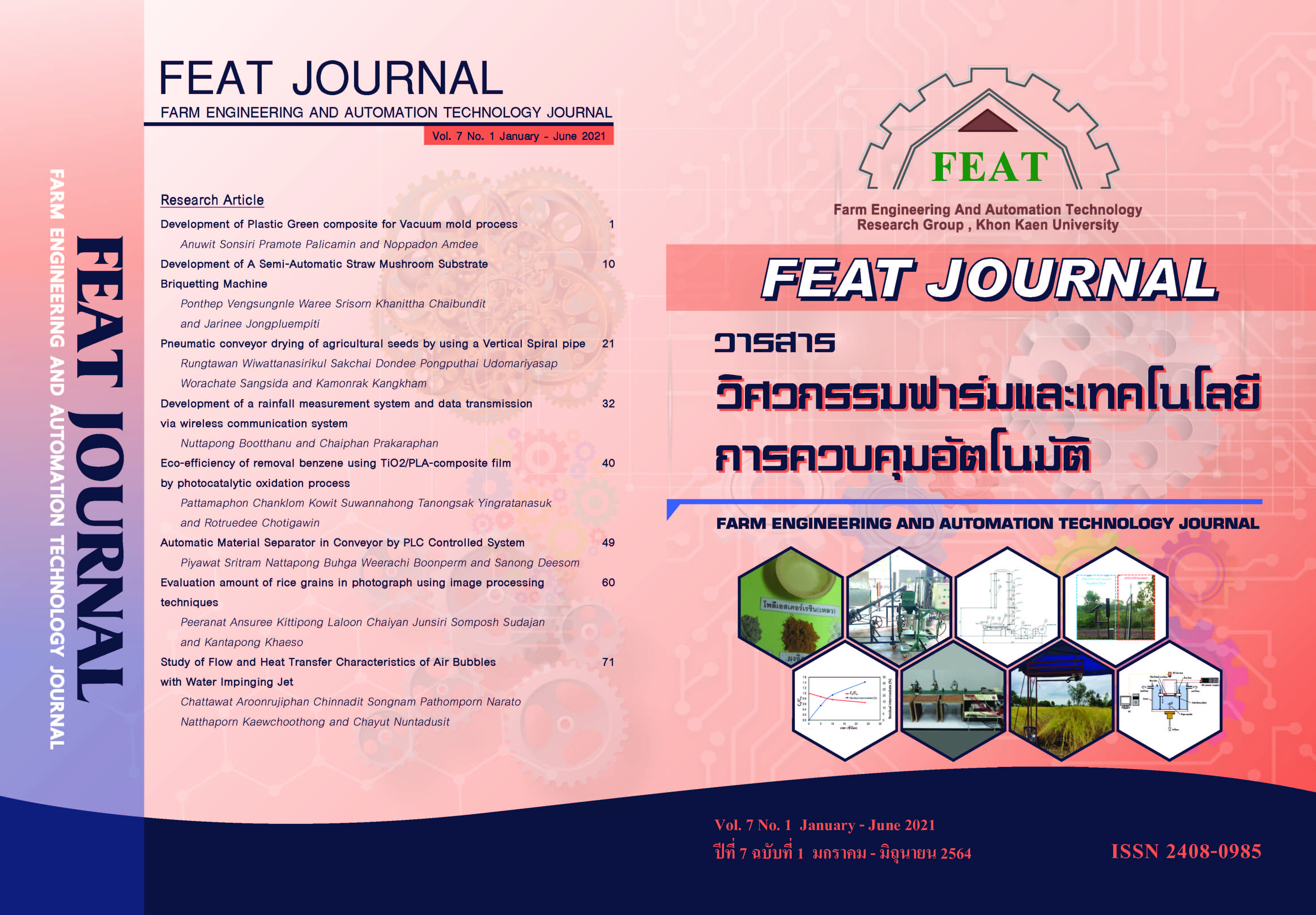การศึกษาลักษณะการไหลและการถ่ายเทความร้อน ของเจ็ทพุ่งชนด้วยน้ำผสมฟองอากาศ
Main Article Content
บทคัดย่อ
งานวิจัยนี้ได้ศึกษาผลของการเติมอากาศที่มีผลต่อการเพิ่มความสามารถในการถ่ายเทความร้อนของเจ็ทน้ำพุ่งชนพื้นผิวเรียบที่จมในน้ำ โดยกำหนดให้เลขเรย์โนลดส์ของน้ำมีค่าเท่ากับ 2.4 x 104 สัดส่วนระหว่างอัตราการไหลเชิงปริมาตรของอากาศกับอัตราการไหลเชิงปริมาตรรวมที่ 0.0 และ 0.1 และระยะจากปากทางออกท่อเจ็ทถึงพื้นผิวที่เจ็ทพุ่งชนที่ L = 2D, 4D, 6D, 8D และ 10D ตามลำดับ ในการศึกษาพฤติกรรมของฟองอากาศในเจ็ทน้ำใช้วิธีการถ่ายภาพด้วยกล้องความเร็วสูง และศึกษาการถ่ายเทความร้อนบนพื้นผิวที่เจ็ทพุ่งชนโดยใช้กล้องถ่ายภาพความร้อน จากผลการศึกษาพบว่าการเพิ่มอากาศที่สัดส่วนระหว่างอัตราการไหลเชิงปริมาตรของอากาศกับอัตราการไหลเชิงปริมาตรรวมเท่ากับ 0.1 สำหรับระยะพุ่งชนที่ L = 2D, 4D, 6D, 8D และ 10D และมีค่าเลขนัสเซลต์เฉลี่ยตามแนวรัศมีเพิ่มขึ้น 27.27%, 1.98%, 24.37%, 3.84% และ 8.10% ตามลำดับ เมื่อเทียบกับกรณีของเจ็ทน้ำที่ไม่ผสมฟองอากาศ ซึ่งเกิดจากพฤติกรรมของฟองอากาศขนาดเล็กที่เกิดการรวมตัวกันเป็นฟองขนาดใหญ่แล้วไหลปะทะพื้นผิว และฟองอากาศขนาดเล็กที่ไหลปะทะบนพื้นผิวและรบกวนชั้นขอบเขตความร้อน
Article Details
วารสารวิศวกรรมฟาร์มและเทคโนโลยีควบคุมอัตโนมัติ (FEAT Journal) มีกําหนดออกเป็นราย 6 เดือน คือ มกราคม - มิถุนายน และกรกฎาคม - ธันวาคม ของทุกปี จัดพิมพ์โดยกลุ่มวิจัยวิศวกรรมฟาร์มและเทคโนโลยีควบคุมอัตโนมัติ คณะวิศวกรรมศาสตร์มหาวิทยาลัยขอนแก่น เพื่อเป็นการส่งเสริมและเผยแพร่ความรู้ ผลงานทางวิชาการ งานวิจัยทางด้านวิศวกรรมศาสตร์และเทคโนโลยีพร้อมทั้งยังจัดส่ง เผยแพร่ตามสถาบันการศึกษาต่างๆ ในประเทศด้วย บทความที่ตีพิมพ์ลงในวารสาร FEAT ทุกบทความนั้นจะต้องผ่านความเห็นชอบจากผู้ทรงคุณวุฒิในสาขาที่เกี่ยวข้องและสงวนสิทธิ์ ตาม พ.ร.บ. ลิขสิทธิ์ พ.ศ. 2535
เอกสารอ้างอิง
Yeh LT. Review of heat transfer technologies in electronic equipment. Journal of Electronic Packaging. 1995; 117(4): 333-9.
Mudawar I. Assessment of high-heat-flux thermal management schemes, IEEE Transaction on Components and Packaging Technologies. 2001; 24 (2): 122–41.
Polat S. Heat and mass transfer in impingement drying, Drying Technology. 1993; 11(6): 1147–76.
Viskanta R. Heat transfer to impinging isothermal gas and flame jets, Experimental Thermal and Fluid Science. 1993; 6(2): 111–34.
Han B, Goldstein RJ. Jet-impingement heat transfer in gas turbine systems. Annals of the New York Academy of Sciences. 2001; 934(1): 147–61.
Zuckerman N and Lior N. Jet impingement heat transfer: physics, correlations and numerical modeling. Advances in Heat Transfer. 2006; 39: 565–631.
Barewar SD, Tawri S, Chougule SS. Heat transfer characteristics of free nanofluid impinging jet on flat surface with different jet to plate distance: An experimental investigation. Chemical Engineering & Processing: Process Intensification. 2019; 136: 1-10.
Donoghue DB, Albadawi A, Delauré, YMC, Robinson AJ, Murray DB. Bubble impingement and the mechanisms of heat transfer. International Journal of Heat and Mass Transfer. 2014; 71: 439-50.
Donoghue DB, Albadawi A, Delauré YMC, Robinson AJ, Murray DB. Mechanisms of heat transfer for axisymmetric bubble impingement and rebound. Heat and Mass Transfer. 2018; 54: 2559-70.
Choo K, Kim SJ. Heat transfer and fluid flow characteristics of two-phase impinging jets. International Journal of Heat and Mass Transfer. 2010; 53: 5692-9.
Fredrich BK, Glaspell AW, Choo K. The effect of volumetric quality on heat transfer and fluid flow characteristics of air-assistant jet impingement. International Journal of Heat and Mass Transfer. 2016; 101: 261-6.
Faghri A, Zhang Y. Two-phase flow and heat transfer. Transport Phenomena in Multiphase Systems. 2006; 853-949.
Glaspell AW, Rouse VJ, Friedrich BK, Choo K. Heat transfer and hydrodynamics of air assisted free water jet impingement at low nozzle-to-surface distances. International Journal of Heat and Mass Transfer. 2019; 132: 138–42.
Baghel BK, Sridharan A, Murallidharan JS. Heat transfer characteristics of free surface water jet impingement on a curved surface. International Journal of Heat and Mass Transfer. 2021; 164: 120487.
Alnak CDE, Varol Y, Firat M, Oztop HF, Ozalp C. Experimental and numerical investigation of impinged water jet effects on heated cylinders for convective heat transfer. International Journal of Thermal Sciences. 2019; 135: 493–508.
Aroonrujiphan C, Nuntadusit C. Flow and Heat Transfer Characteristics of Impinging Bubbly Jet. Journal of Advance Research in Fluid Mechanics and Thermal Sciences. 2020; 74(1): 68–80.
Cengel YA, Ghajar AJ. Heat and Mass Transfer: Fundamentals and Applications. Natural Convection. 2015; 533-5.


